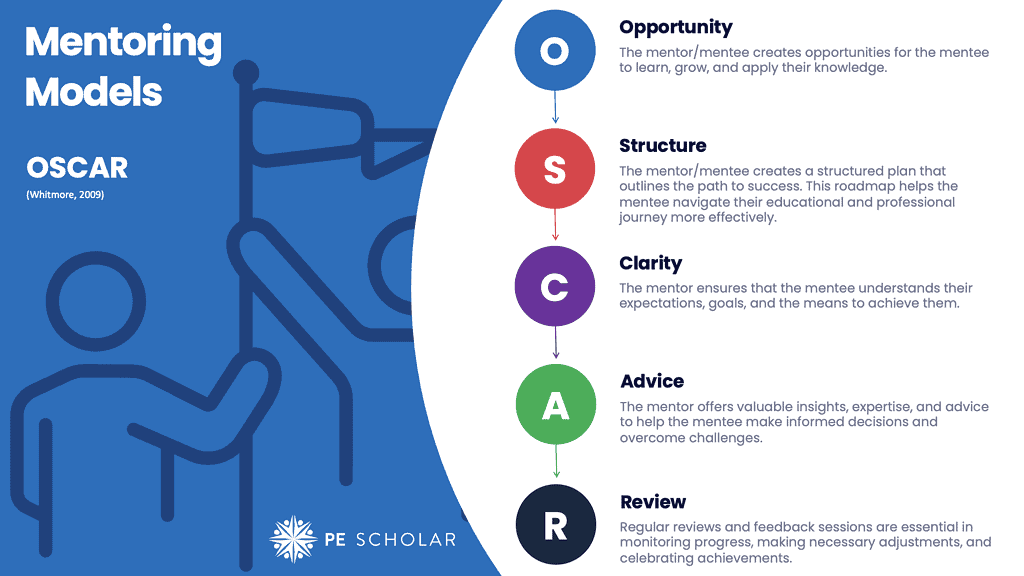
Introduction
Mentoring in teaching is of immense value, benefiting not only the mentee but also the mentor. Mentoring is something that is synonymous with being a trainee teacher or early career teacher, but it can also support established and experienced teachers. There are a range of mentoring models that can help support mentors, we have outlined some of the most popular below:
Mentoring Models in PE
Here are four popular mentoring models, including the OSCAR mentoring model, GROW mentoring model, CIGAR mentoring model, and STRIDE mentoring model.
OSCAR Mentoring Model (Whitmore, 2009)
The OSCAR mentor model is a highly effective mentoring framework for PE. It focuses on the mentor providing Opportunity, Structure, Clarity, Advice, and Review to the mentee. Each component of the model plays a critical role in supporting development.

- Opportunity – Start by creating opportunities for the mentee to learn, grow, and apply their knowledge.
- Structure – The mentor/mentee creates a structured plan that outlines the path to success. This roadmap helps the mentee navigate their educational and professional journey more effectively.
- Clarity – The mentor ensures that the mentee understands their expectations, goals and the means to achieve them.
- Advice – The mentor offers valuable insights, expertise, and advice to help the mentee make informed decisions and overcome challenges.
- Review – Regular reviews and feedback sessions are essential in monitoring progress, making necessary adjustments and celebrating achievements.
GROW Mentoring Model (Whitmore and Gilbert, 2002)
The GROW mentor model is a widely recognised framework for mentoring, which stands for Goal, Reality, Options, and Will. It is a simple yet effective approach to guide mentees in their PE teaching journey.

- Goal – The mentor helps the mentee define clear and achievable goals. In PE, these goals might pertain to skill improvement, fitness, or academic objectives.
- Reality – Together, the mentor/mentee assess the current situation, taking into account strengths, weaknesses, and challenges.
- Options – The mentor/mentee map out potential strategies and actions that can lead to goal attainment. This phase encourages creative problem-solving.
- Will – In the final stage, the mentee commits to taking action and demonstrates the determination to follow through with the chosen plan.
CIGAR Mentoring Model (Green and Grant, 2003)
The CIGAR mentor model is designed to be a comprehensive and dynamic mentoring approach in the field of PE. It stands for Coaching, Inquiry, Guidance, Advice, and Reflection.

- Coaching – The mentor provides guidance on content and pedagogical delivery.
- Inquiry – Open and thought-provoking questions are used to stimulate critical thinking and self-awareness in the mentee. This encourages mentees to reflect on their practice and seek answers independently.
- Guidance – Mentors offer structured guidance, which may include clear targets and goal setting.
- Advice – Practical advice is given by the mentor based on their own experiences and expertise in PE.
- Reflection – This component encourages both the mentor and the mentee to reflect upon progress and set the next goal for continuous improvement.
STRIDE Mentoring Model (Thomas and Smith, 2009)
The STRIDE mentor model is a more recent addition to the mentoring landscape in PE. It emphasises Self-awareness, Target setting, Reflection, Innovation, Development, and Evaluation.

- Self-awareness – Mentees are encouraged to gain a deep understanding of their strengths, weaknesses, and personal goals.
- Target setting – Setting specific, measurable, achievable, relevant, and time-bound (SMART) goals is essential for progress.
- Reflection – Regular self-reflection and evaluation enable mentees to learn from their experiences and continuously adapt their strategies.
- Innovation – Creativity and innovation are encouraged to find new and effective ways to achieve goals and overcome obstacles.
- Development – This step focuses on continuous personal and professional development, including further education and training.
- Evaluation – Regular assessment and feedback loops ensure that progress is monitored and goals are adjusted as needed.
The choice of the model will depend on individual preferences, objectives, and the dynamics of the mentor and mentee relationship.
Benefits of Mentoring
There are multiple benefits of mentoring, we’ve outlined just a few advantages below:
1. Professional and Career Development
Mentoring is a powerful tool for enhancing the professional growth of educators.
Experienced mentors provide guidance, share best practices, and help mentees develop their confidence and competence.
Through mentorship, teachers can continuously improve their instructional methods, classroom management, and curriculum development.
Effective mentors are able to model practice for early career teachers to help accelerate their practice and career development.
2. Retention and Job Satisfaction from Peer Mentoring
Effective mentoring can improve teacher retention rates by offering support and a sense of belonging.
New teachers or new employees often face and experience numerous challenges, and a mentor can help them navigate the complexities of the profession.
Mentors are often more experienced peers who have a expertise that they can share with the mentee.
When teachers feel supported and satisfied in their roles, they are more likely to remain a teacher.
3. Personalised Learning
Mentors can tailor their guidance to the specific needs and goals of individual mentees.
This personalised approach allows educators to address their weaknesses, enhance their strengths, and make meaningful progress in their teaching careers.
This benefits both the mentor and the mentee by fostering a mutually rewarding professional relationship.
4. Classroom Management
Mentoring can assist teachers in developing effective classroom management strategies.
Effective mentors can share insights into creating a positive classroom environment, handling discipline issues, and engaging students in meaningful learning experiences.
Student behaviour has been cited as one of the leading causes of teachers leaving the profession.

5. Student Achievement
High-quality mentoring can have a positive impact on student learning outcomes.
When teachers are supported and equipped with effective teaching methods, students are more likely to excel.
Mentoring helps educators continually refine their instructional practices to meet the diverse needs of their students.
6. Reflective Practice
Mentoring encourages teachers to engage in reflective practice, which involves critically examining their teaching methods and making informed adjustments.
By regularly reflecting on their teaching experiences and receiving feedback from mentors, educators can refine their approaches and become more effective in the classroom.
Regular mentoring can also help you to reflect on your career goals and good mentors will help their mentees plan for upward mobility and progression.

7. Professional Networking
Mentoring often introduces educators to a network of colleagues and resources that can be invaluable in their careers.
This network can lead to collaboration, sharing of ideas, and opportunities for professional development and growth not only for the mentee but also for the mentor. Having access to multiple mentors also enables you to tap into a wider network of expertise and access further knowledge sharing.
8. Building a Supportive Community
Mentoring helps create a supportive and collaborative educational community.
Through mentor and mentee relationships, educators learn from one another, share experiences, and work together to solve problems, fostering a sense of camaraderie. It can accelerate your career advancement and expose you to a range of new perspectives.
You can have one mentor or seek out multiple mentors who offer different expertise, for example you might have a subject mentor who teaches the same subject and another mentor outside of your subject area.
9. Continuous Improvement
Teaching is an evolving field which typically involves gaining insight with changing educational practices and technologies.
Mentoring enables educators to stay up-to-date with the latest trends and innovations, ensuring they remain effective and adaptable in an ever-changing educational landscape.
10. Leadership Development
Mentoring can also develop leadership skills and prepare educators for a future leadership role. Having a role model in a leadership role can be useful in helping to support mentees in shaping their career path and preparing for career advancement.
Conclusion
Effective mentoring relationships create a supportive community that fosters growth, collaboration, and excellence in teaching. Mentoring models in PE, such as the OSCAR model, GROW model, CIGAR model, and STRIDE model, offer diverse approaches to personal and professional growth.
Regardless of the model chosen, successful mentoring in PE is built on trust, open communication, and a shared commitment to excellence. Having an effective mentor can be a useful resource to support your career aspirations and career success.
More information and support
If you would like more information on how to support mentees in PE we are soon to be launching a mentoring course for PE teachers. Please contact us for more information.
The infographics can also be accessed below:


Responses